 WOW! Talk about historic finds! DC Comics just tweeted this historic photo from a comics industry Christmas party from 70 years ago. While there is a slight Shining view to it (is that Hank Kanalz I see in the back?), it's also an amazing view into the Golden Age. After it was tweeted DC Comics was kind enough to send me a high res scan which I am sharing with you so all the comics historians out there can pour over it. There is a handwritten guest list as well, but its provenance isn't known so I am not posting it.
WOW! Talk about historic finds! DC Comics just tweeted this historic photo from a comics industry Christmas party from 70 years ago. While there is a slight Shining view to it (is that Hank Kanalz I see in the back?), it's also an amazing view into the Golden Age. After it was tweeted DC Comics was kind enough to send me a high res scan which I am sharing with you so all the comics historians out there can pour over it. There is a handwritten guest list as well, but its provenance isn't known so I am not posting it.
Viewing: Blog Posts Tagged with: golden age, Most Recent at Top [Help]
Results 1 - 12 of 12
Blog: PW -The Beat (Login to Add to MyJacketFlap)
JacketFlap tags: History, Cartoonists, DC, comics history, golden age, Joe Kubert, harry donnefeld, jack adler, NPP, Add a tag
Blog: PW -The Beat (Login to Add to MyJacketFlap)
JacketFlap tags: Comics, Marvel, golden age, new release, Downloadable Comics, Marvel Comics, Mobile Comics, Digital Comics, Top News, Magneto, Scarlet Witch, James Robinson, Top Comics, Amanda Sefton, Vanesa Del Rey, Add a tag
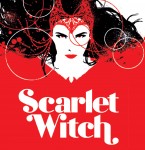 By: Nick Eskey Writer: James Robinson Artist: Vanesa Del Rey Colorist: Jordie Bellaire Letterer: Cory Petit Cover Artist: David Aja Taking place after her stint in the Avengers team, James Robinson’s Scarlet Witch is now as she claims “alone.” The only acquaintance that we’re introduced to is the ghost of her old tutor in witchcraft, Agatha Harkness, who happens to […]
By: Nick Eskey Writer: James Robinson Artist: Vanesa Del Rey Colorist: Jordie Bellaire Letterer: Cory Petit Cover Artist: David Aja Taking place after her stint in the Avengers team, James Robinson’s Scarlet Witch is now as she claims “alone.” The only acquaintance that we’re introduced to is the ghost of her old tutor in witchcraft, Agatha Harkness, who happens to […]
Blog: Cartoon Brew (Login to Add to MyJacketFlap)
JacketFlap tags: Golden Age, Zoolander, Will Ferrell, Jenny Slate, Superjail, Augenblick Studios, Aaron Augenblick, Alan Foreman, Frenzer Foreman Animation Forum, Joel Frenzer, Cartoon Brew Podcasts, Ugly Americans, Cain's Tavern, Wonder Showzen, Add a tag
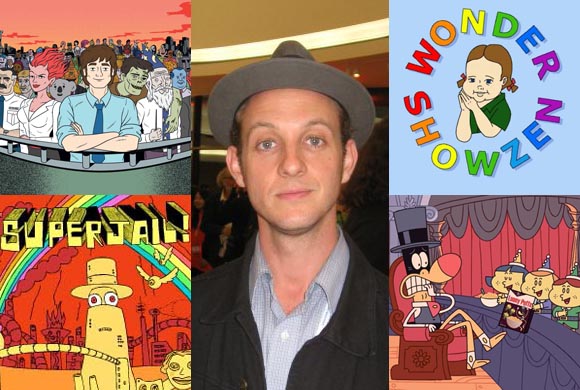
(This episode contains strong language.)
Over the last fourteen years, Aaron Augenblick has built up Augenblick Studios into one of New York City’s most respected production studios. The studio has produced animation—in Brooklyn!—for series such as Wonder Showzen (MTV2), Ugly Americans (Comedy Central), Superjail! (first season, Adult Swim), as well as the festival circuit hit Golden Age. The studio’s current major project is an animated feature based on the Ben Stiller live-action pic Zoolander.
In the latest episode of Frenzer Foreman Animation Forum, Augenblick talks about creating a studio from the ashes of bad advice, how a young studio finds work, the challenges of being a studio owner and artist at the same time, tips for building an artistic community and fostering studio pride, why he refuses to expand his studio beyond a set number of employees, and the importance of submitting animated shorts to festivals even if you’re producing commercial work.
LINKS RELATED TO THIS EPISODE
Augenblick Studios: WEBSITE and FACEBOOK PAGE
Cain’s Tavern: WEBSITE and FACEBOOK PAGE
Golden Age series
Ramblin’ Man:
Blog: Shelley Scraps (Login to Add to MyJacketFlap)
JacketFlap tags: golden age, antiquarian books, arthur rackham, Add a tag
There's so much talk about new technology, of tablets and Apps, e-Books versus print publishing, it's difficult to know where you stand sometimes. None of us wants to be left behind in this digital revolution, we're told that e-publishing is a path of opportunity for illustrators. That's good news, I'm all for new opportunities, I must admit to being amazed by what can be achieved with technology. Nevertheless I'm not sure where I personally fit into this heady world of new media. I suppose I'm enthusiastic for, but not an avid enthusiast of ebooks and their like.
The more I contemplate ebooks, the more I think back to why I pursued the publishing industry in the first place. I thought I'd take a moment then to post a bit about what I love about old books. And I mean old books!
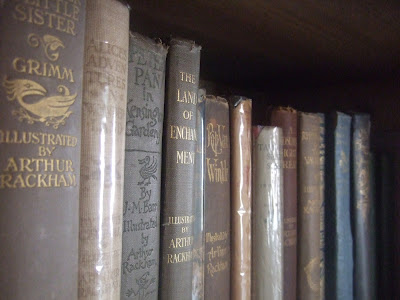 |
| Golden Age treasures |
I became an illustrator as the result of a love affair with books, initially from childhood trips to the library, where I discovered Edward Ardizzone, Quentin Blake and E.H. Shepherd, and fascination with the illustrations in my mum's old 1920's volumes of Fairy Tales. Thereafter I became absorbed in coffee-table art and history books showing the work of painters, engravers and especially graphic masters like Hogarth and Rowlandson. And then at the particularly impressionable age of 15, came the discovery of the Golden Age illustrators: Arthur Rackham, Edmund Dulac, the Robinson brothers and their contemporaries, and I was transported, head-over-hills, to kingdoms far away. When it comes to books, I'm an incurable romantic.
In this post though, rather than the illustrators and their work I want to focus on the media - the printed books. Aside from the superlative quality of the art, the production of the books themselves was an inspiration in their own right, especially the lavish Gift Books of the era. Years ago I began collecting First and Deluxe edition titles from the Golden Age, mostly Arthur Rackham but others too, sometimes through auction, some via antiquarian bookshops. I won't go on about the years spent blissfully rummaging through the shelves of antiquarian and second-hand bookshops looking for hidden rare nuggets. Suffice to say - I'm a disciple, pen and ink masters have enraptured me throughout my career. Despite all the upheavals in my life over the years I still have a couple of bookshelves enshrined as homage to my heroes.
What is the "Golden Age"? In loose terms, it's the period between the broad introduction of modern photographic 4-colour printing in the 1870's (when for the first time the work of illustrators could be reproduced exactly as the original art) and the close of the First World War, which heralded a change in publishing tastes and budgets.
What is a "Golden Age Gift Book"? Usually these were large sized (quarto or similar) books, often released to time with the Christmas season to be presented as gifts. Collected fairy tales, classics and modern fantasies were most common. The standard 'trade' editions were of cloth binding with inlaid gold lettered cover, often including illustration and designed by the illustrator themselves. In contrast dust jackets were often quite austere and surviving examples are rare today.
 |
| Cover of Milton's Comus with Rackham's Dust Jacket. Published by Heinemann, printed by The Cornwall Press in London in 1921. |
The books were printed in letterpress on high quality heavy paper, with generously wide margins, and often interspersed with black and white illustrations. The pages were sometimes left untrimmed, leaving a rough uneven edge, all of which adds to the sense of quality.
The real stamp of the gift book though were the colour illustrations. As the process of photo-litho colour reproduction was quite new, colour illustrations were printed on separate sheets of coated art paper 'plates', which were glued down onto coloured mounting sheets, usually just along one edge, and covered with a sheet of tracing paper carrying the image caption. The tracing paper was ostensiably to protect the delicate colour image from rubbing on the paper, though it was soon clear this was unnecessary and the practice became more for show and to convey a sense of exclusivity. These were then bound into the book separately.
 |
| Deluxe edition of Rackham's 1907 Alice's Adventures in Wonderland - big margins, tipped in colour plate and tissue guard. |
For me there is no other reading experience more satisfying than browsing through these books. The sense of lifting the tracing paper to see the gem of illustration beneath is a pleasure only books can give. These are books to be read with deference. The trade editions were intended to be read, re-read and treasured by children and adults, and they still have that effect today. There will never be an App that gives me the same glow as handling these old tomes.
 |
| Title page of the 1908 Trade first edition of Rackham's Midsummer Night's Dream. Again published by Heinemann, and printed by The Ballantyne Press in London. |
More elevated still though are the signed deluxe limited editions. Ordinary Trade editions would run to 15,000 or more for their first impression, but for the top selling artists a limited number of specially bound deluxe editions would be printed, generally between 350 and 1,000 copies only, each numbered and signed by the artist. The deluxe editions were larger and heavier than the trade editions, usually bound in heavy buckram rather than cloth, with ribbon ties (few of these survive) and sometimes with an extra illustration. These are my Deluxe edition Rackham's :
These books demand a lot of respect. Running my fingers lightly over the page, I can feel the impressions of the text and black and white illustrations pushed into the surface of the paper by the blocks, the creak of the spine as I slowly, methodically turn each page, then the wonderful sense of anticipation as I reach a colour illustration and peel back the delicate tracing paper to reveal the image beneath. The limited editions have a more exclusive quality to them, the pages more difficult to turn, not for prying children's grubby fingers. And that kind of defeats the object of the book! So as reading books I actually much prefer the trade editions, though I still occasionally read to my daughter at night from signed copies of Rackham's 1909 Grimm or 1918 English Fairy Tales.
Though such Gift Books went out of fashion in the 1920's, very fine books by smaller presses continued to be made until World War 2 knocked the stuffing out of the market. Fine books have returned since then of course. I've always dreamed of seeing my books made like those of my heroes. This is not an ambition with much likelihood of success, though I knew that before I became an illustrator. It didn't stop me dreaming though, I'll never forget the first time I handled these old books, my love for children's illustration and the Golden Age era in particular is what set me on the determined path to follow in the footsteps of the "greats".
It's not only the big Edwardian gift books I get excited about though, any old well illustrated book is liable to attract my attention, my collection ranges from books big or small, finely produced or WW2 budget printing. This is all in addition to the shelves of modern picture books etc. I've precious little space for anything now, though I did relinquish a lot of books when I moved back to the UK, some which I now regret.
 |
| War economy edition of Mervyn Peake's Household Tales |
The oldest books in my little collection are not children's books at all, but a handful of military diaries from the 1790's, published campaign reports of officers serving under the Grand old Duke of York in Flanders in the early wars of the French Revolution (it's a period I've long been fascinated by). Few of these are illustrated, but they do contain some beautifully detailed engraved maps and calligraphy. Though very different from the Golden Age books, I love them just as much. The sense of these works being published in the forefront of such incredible times adds to the fascination.
 |
| Map of the Duke of York's position at Tournai, June 1794 in Jones's History of the British Campaigns of 1794 & 1795. Printed by Swinney and Hawkins in Birmingham 1797. |
So that's my little indulgence. I don't add to the collection nowadays, budget, space and circumstances prevent that, but I'm holding onto what I've got. These books have travelled with me from the UK to Japan and back again so I'm not about to get rid of any of them soon.
E-books may be an exciting future for children's publishing, and I certainly aim to be part of that. But alongside the digital boom many publishers are saying that a new focus on collectable, well produced, carefully crafted books is also a way forward to re-ignite the traditional printed book market. I think that's very good news.
Blog: Shelley Scraps (Login to Add to MyJacketFlap)
JacketFlap tags: golden age, antiquarian books, arthur rackham, Add a tag
I wouldn't say I love them, but I've no problem with vultures, they're a crucial part of the eco-system, their talent for waste disposal is unparalleled, without them we'd be in big trouble. In India the catastrophic decline of the vulture population has led to epidemics and streets filled with rabid feral dogs.
It's not the feathered variety of vultures I'm thinking of, but the literary kind. The sort that, when you're gone, take what remains of your reputation, and clean, strip, sell and market your work. I refer of course, to those efficient scavengers the galleries and bookshops.
I've been an incurable fan of antiquarian bookshops since I can remember, the smell of musty volumes on dimly-lit shelves bent with the weight of the printed word, the anticipation of discovering a valuable gem missed by the shop owner, sold for a fraction of it's true worth. The joy of perusing beautifully crafted tomes I could never afford, as well as more commonplace insights into everyday life of yesteryear. Then, as I began working and budget increased, I slowly started to accumulate work by my favourite illustrators - first editions of E. H. Shepherd, Rackham, Dulac, Ardizzone, Peake. As I don't drive and had no interest in sports, collecting books was one of the few areas I'd reward myself, what more fitting way to celebrate my publishing royalties than buying books by my long-gone heroes.
I avoided book dealers when I lived in Japan, I saved my old book hunting for my trips back to London, and kept the books in the UK. There are antiquarian bookshops in Tokyo (especially in the Jimbocho district), but the kind of books I sought (Golden Age Illustrated Children's) are imported and vastly overpriced, while the Japanese climate is never kind on printed paper.
 |
| Part of the dry-case collection while in Japan |
Now I'm based back in London the lure of the old bookshop beckons once more.
For me, antiquarian bookshops are the ultimate tribute for an illustrator. After you're gone, when all that's left are your old books and a few precious originals in galleries and private collections, to have your work exalted in price and preserved on bookshelves is a wonderful thing.
Blog: Sugar Frosted Goodness (Login to Add to MyJacketFlap)
JacketFlap tags: animation, poster, robot, golden age, gallery show, Shazam, chogrin, Betty Boop, brave new worlds comics, the autumn society, golden age show, captain marvel, Eamon Dougherty, Add a tag
Come see the astonishing Autumn Society at their thrilling 4th gallery show! Featuring works of art inspired by the glorious Golden Age of Comics and Animation!
The event will be hosted by the brave and bold folks at Brave New Worlds Comics, Tomorrow, July 3rd, at 6pm! Be there!
Blog: ART JUMBLE Blog (Login to Add to MyJacketFlap)
JacketFlap tags: golden age, Chogrin, popeye, The Autumn Society, golden age show, Golden Age Heroes, Add a tag
My first submission for the Autumn Society's Golden Age Show. The show will feature heroes from the golden age of comics and animation, illustrated by the society's members. I've always been a huge Popeye fan since my grandfather was also a sailor. So growing up I always related both to each other.
Blog: Sugar Frosted Goodness (Login to Add to MyJacketFlap)
JacketFlap tags: promo, vector, postcard, golden age, king, pink, chogrin, icecreampeople.org, brian butler, ice cream people, Add a tag
Inspired by Peter Wonsowski's Winton Green cone, here's my cone for Brian Butler's Ice Cream People project, King Cholado of Chalamello land! See more of these at the link below!
Blog: I.N.K.: Interesting Non fiction for Kids (Login to Add to MyJacketFlap)
JacketFlap tags: 2008 titles, Kathleen Krull, edginess, golden age, 2008 titles, edginess, golden age, Add a tag
Fascinating information, distilled into age-appropriate language, fully synthesized by a warm and witty authorial presence, narrated in a compelling voice… illustrated/visualized with flair… labored over by smart editors, copyeditors, fact-checkers, and designers….
Can a children’s nonfiction book be a work of art, a hallmark of civilization, a gem among gems, a---- OK, OK, I’m biased. But is it possible that we live in a golden age for children’s nonfiction books? Or have I gone over the edge?
Let’s consider some juicy titles so far in 2008.
Newcomer (to children’s books) Philip Dray tackles the harrowing subject of lynching in Yours for Justice, Ida B. Wells: The Daring Life of a Crusading Journalist. The executions of black citizens, completely outside the law, began almost as soon as the Emancipation Proclamation was signed, reached a peak of one almost every other day, and didn’t end until the 1950s. Sensibly, Dray clothes his topic within a biography of one courageous person, Ida B. Wells. She was born a slave in 1862, started teaching school at 16, and became a noted journalist. Publishing articles, giving speeches, often at great personal risk, she used her fame to shed light on the horrors of lynching, becoming the most effective crusader against it. The reader comes to know Wells in full detail, with six pages of solid information in the back matter for extra value. Stephen Alcorn’s stylized watercolors swirl with Wells’s energy and anger—just look at the cover with page after page radiating from her rising figure. Recent events in the news make this book a must-have for schools (Peachtree Publishers, 2008, ages 10-14).
Former mighty librarian Julie Cummins flexes her mighty research muscles in Women Daredevils: Thrills, Chills, and Frills. Male daredevils are all over the place, ho hum. But have you ever heard of May Wirth (billed as the Greatest Bareback Rider Who Ever Lived), Zazel (known as the Human Cannonball), Annie Edson Taylor (first person to go over Niagara Falls in a barrel), or Mabel Stark (“the world’s greatest tiger tamer and trainer”)? I haven’t, nor of any of the fourteen action-loving performers in this book. Their feats were all the more astonishing for taking place between 1880 to 1929, an era when women were supposed to sit still and not engage in sports, much less extreme ones. Cummins delves into her daredevils’ exploits, their motives, what they did in their off hours, and what else is known about their lives. A great gift for athletic kids, and a real contribution to women’s history, with Cheryl Harness’s illustrations leaping ecstatically off the page (Dutton, 2008, ages 8-12).
Befitting its rowdy subject, both text and art simply sizzle in What to Do About Alice: How Alice Roosevelt Broke the Rules, Charmed the World, and Drove Her Father Teddy Crazy!. Teddy would be Theodore, who famously moaned, “I can be president of the United States, or I can control Alice. I cannot possibly do both.” Alice liked to call her rambunctious style of living “eating up the world,” and it frequently got her in trouble at a time when proper young ladies had tiny appetites. Besides learning about one unusual woman, history-lovers will appreciate that the reader learns a lot about the President, his election to office in 1901 after Alice turned 17, and how and why she boosted his popularity. Barbara Kerley’s spirited storytelling skills are matched with newcomer Edwin Fotheringham’s ingenious depictions of one of the biggest celebrities of her day. Though we believed her dead since 1980, Alice strikes again! (Scholastic, 2008, ages 4-8).
You want more recommendations? I got plenty. What hot books have YOU noticed so far this year?
Finally—and for a book not about a woman and really silly—coming your way is my next book, called Fartiste. 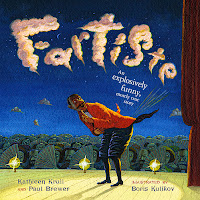
It’s a biography of a unique performance artist who had audiences literally fainting with laughter at Paris’s Moulin Rouge in the late 1800s. Joseph Pujol perfected “the art of the fart” by training his, er, muscles to mimic sound effects, tunes, stories. No, I’m not kidding, and yes, it’s all true. If you think this is gross, blame my husband, illustrator Paul Brewer, collector of extremes of information, amidst which he discovered Pujol, little-known now but in his day the most famous performer in the world. We co-wrote the story in verse, passing the manuscript back and forth to tweak the humor to its max. It’s being published by the brave souls at Simon & Schuster this June, with illustrations by Boris Kulikov that somehow quadruple the fun.
We think the book will have kids rolling on the floor. But what will the grown-ups say—the reviewers, teachers, librarians? Paul and I are on pins and needles (not the best image to associate with our promo item--whoopee cushions). Have we seriously gone over the edge?
Note: The links are to oh-so-convenient Amazon, but for actual purchases your local independent bookstore is the best friend a children’s nonfiction writer could have. I apologize for the lack of graphics, but just getting the links to Amazon in here nearly killed me.
Blog: Miss Snark, the literary agent (Login to Add to MyJacketFlap)
JacketFlap tags: other voices other rooms, Add a tag
I always love hearing editors talk about what they do so I leaped on this youtube video of Alison at Bleak House.
Watch for the shot when she's looking at the mail. Take a good long look. That's the mail for a week. Notice how much of it there is? That's the reason you don't do anything stupid in your query.
Blog: Miss Snark, the literary agent (Login to Add to MyJacketFlap)
JacketFlap tags: other voices other rooms, Add a tag
"The test of whether or not a writer has divined the natural shape of his story is just this: after reading it, can you imagine it differently, or does it silence your imagination and seem to you absolute and final."
Blog: Miss Snark, the literary agent (Login to Add to MyJacketFlap)
JacketFlap tags: other voices other rooms, Add a tag
Every single day there are 20 query letters waiting for me.
No jacket flap copy to tell me it's a masterpiece, no blurbs, no marketing copy.
Just raw pages.
One of the very very hardest things about being an agent is learning to read stuff and identify really good things with no clues. Frankly, I'm still not as skilled at that as I hope to be (take comfort all you undiscovered masters out there!).
I think of that when I read things like this in the Washington Post.
And I always give money to street musicians.










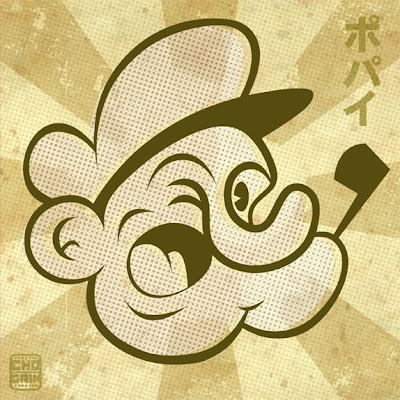

I’m glad to hear that an Archive team was put together. I hope they manage to find the CCA archives somewhere in there!
http://robot6.comicbookresources.com/2014/04/where-are-the-archives-of-the-comics-code-authority/
This is wonderful! Thanks for posting the smaller scan. I understand the full-resolution version is too big to post here, but is there a link to somewhere else that it can be found?
Their fashion is incredible – suits for the men and elegant outfits with hats for the ladies. They look like they’re having a great time.
I’m not sure what the hubub is about the ” lost” 1939 96-page WORLD’S FAIR comic. There are other copies around, and DC even reprinted the entire issue in the Archives: http://www.comics.org/issue/297576/ .
Heidi M. wrote: “The men of DC must have invited all of their mothers, girlfriends and wives. Or maybe some of them even worked in comics during the War years?”
Yes, a lot of women were hired as writers and artists during WWII. When the men came back, most of them lost their jobs, which happened in every industry.
I’d imagine that some of DC’s young male employees were still in uniform at this point (only four months after Japan’s surrender).
Wow! Kudos to DC for this. And for sharing here!
This was right after DC and All-American Merged operations completely after a split for a year.